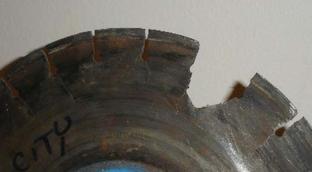Proper mounting the blade may seem simple but is critical to safe operation. Before installing a new blade, double check the arbor shaft for wear, radial, and axial play. If you move the shaft back and forth and there is movement, it means the arbor shaft needs new bearings, adjustment, or even to be replaced.
Let the saw do the work. All you need to do is guide it in the direction of the cut. Forcing the blade could cause it to overheat. Segmented blades have slots cut into the core that allow water and air to flow, providing faster cooling.
- Blades are designed to go in a straight line; crooked or off-line cuts can cause blades to pinch or bite into the material and jam. Although a blade may be jammed, the running motor builds up power and can cause a worker to lose control of the saw and become exposed to the cutting blade.
- Make sure the flanges are smooth and flat without wear, and that they are of equal and correct diameter. Ensure that the blade is mounted on a correct diameter blade shaft between proper blade flanges and is securely tightened with an adjustable wrench.
- Pay attention to the RPM and directional arrows labeled on the blade to ensure the blade is installed properly and spins in the intended direction.
- Make sure there is a regular flow of water on each side of the blade, and make sure there is enough coolant on hand. Check that each of the two coolant tubes located on either side of the blade are not damaged or pinched shut. If blades are used without enough water, the actual diamond segments may break off. Regularly inspect the diamond blade for undercutting, fatigue cracks, core flatness, segment damage, and arbor hole wear while you use it.
Keeping the blade shaft bearings lubricated is one of the most important daily maintenance procedures. These bearings should be greased at the end of every work day. Many manufacturers recommend giving each bearing two pumps of grease while the machine is still warm from operation, if possible, and while the shaft is turning over at idle speed.
All blades come with a lettered Blade Application Code developed by the Concrete Sawing and Drilling Association and are in the following format: Blade code (X – X – X)
- 1st X Wet only (W) or Wet or dry (D)
- 2nd X Cured concrete (C), Green concrete (G) or Block/brick (B)
- 3rd X Handheld (H), Wall saw (W) or Stationary saw (S)


 RSS Feed
RSS Feed
